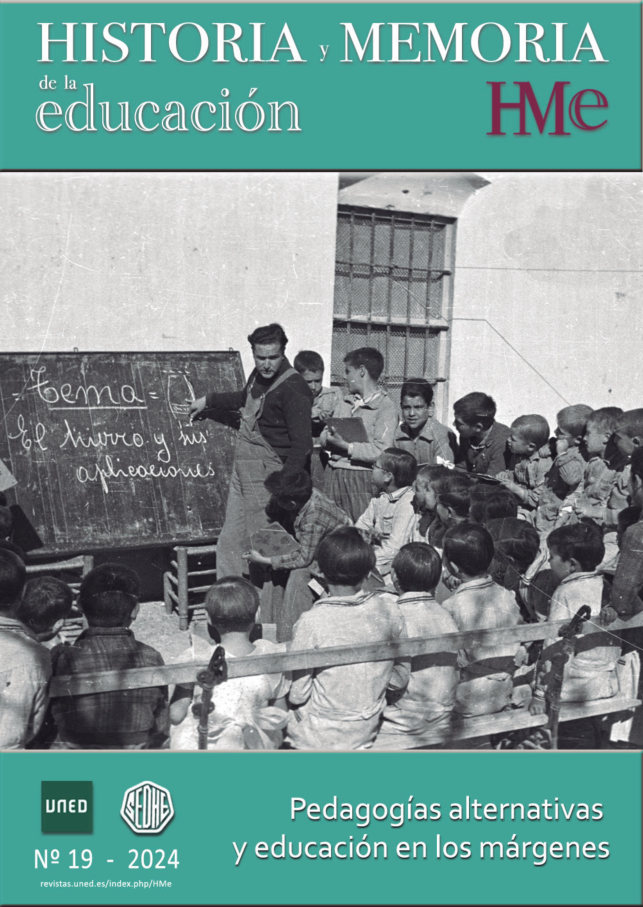Paola Carrara Lombroso and picture postcards as educational products: A way to educate young readers and citizens of tomorrow
DOI :
https://doi.org/10.5944/hme.19.2024.35724Mots-clés :
Picture postcards, Corriere dei Piccoli, Children's Literature, ItalyRésumé
In Italy picture postcards were disseminated during the Giolitti era and throughout the Great War, thus becoming a concrete medium with a pervasive potential. Postcards influenced mass culture by constructing a collective imagination, they promoted the education of adults as well as of young people. As postcards reflected the shape of cultural industry by reproducing large scale images, they stemmed from a complex productive process that became a language of its own, starting from the artistic originality of the image to the printed form, reaching a wider audience both in terms of visual education and as swift communicative tool. In 1909 in Corriere dei Piccoli (1908-1995), the most prominent magazine for children in Italy at the time, Paola Carrara Lombroso (1871-1954) began the project for Bibliotechine per le scuole rurali (Libraries for rural schools), destined to a success until halfway through the Twentieth century. The young readers of the magazine took part with initiative by colouring and selling postcards created by Italian artists. The sum raised was used to donate books to rural schools. This research wishes to analyse a sample of postcards illustrated by well-known artists such as Mussino, Golia, Altara, Bologna and Gugù in order to shed light on the way childhood was represented. Toys, books, expressions and clothes are visual evidence of the multiple perspectives that adults adopted to reach children through entertainment. The artist’s gaze met child readers as they became protagonists and at the same time owning that message by modelling their thought and imagination.
Téléchargements
Références
Aries, Philippe. Centuries of Childhood: A Social History of Family Life Centuries of childhood. London: Jonathan Cape, 1962.
Callegari, Paola and Enrico Sturani, eds. L'Italia in posa: cento anni di cartoline illustrate. Neaples: Electa, 1997.
Cantatore, Lorenzo. «Con il diavolo zoppo fra verità e fantasia. La corrispondenza di zia Mariù». In Il «Corriere dei Piccoli» in un secolo di riviste per ragazzi, edited by Renata Lollo, 73-85. Milan: Vita & Pensiero, 2009.
De Fort, Ester. Scuola e analfabetismo nell'Italia del '900. Bononia: Il Mulino,1995.
Dekker, Jeroen J.H. «Images as Representations: Visual Sources on Education and Childhood in the Past». Paedagogica Historica 51, no. 6 (2015): 702–715
Depaepe, Mate and Bregt Henkens, «The Challenge of the Visual in the History of Education». Paedagogica Historica 36, no. 1 (2000): 10-17.
Dolza, Delfina. Essere figlie di Lombroso. Due donne intellettuali tra ‘800 e ‘900. Milan: Franco Angeli, 1990.
Faeti, Antonio. Guardare le figure. Turin: Einaudi,1972.
Fava, Sabrina. Piccoli lettori del Novecento. I bambini di Paola Carrara Lombroso sui giornali per ragazzi. Turin: Sei, 2015.
Fochesato, Walter. Il gioco della guerra. Novara: Interlinea, 2015.
Gibelli, Antonio. Il popolo bambino. Infanzia e nazione dalla Grande Guerra a Salò. Turin: Einaudi, 2005.
Isnenghi, Mario. Il mito della Grande Guerra. Bononia: Il Mulino, 1997.
Isnenghi, Mario. La Grande Guerra degli italiani 1915-1918. Milan: Rizzoli, 2014.
Meda, Juri. «Paola Marzola Carrara Lombroso». In Dizionario biografico dell’educazione, edited by Giorgio Chiosso and Roberto Sani, vol. 2; 46-47. Milan: Editrice Bibliografica, 2013.
Mietzner, Ulrike. Myers, Kevin and Nick Peim. Visual History. Images of Education. Bern: Peter Lang, 2005.
Modoni Georgiou Mirca. Gugù. Migliaia di bambini nella mente. Ravenna: Edizioni Capit, 20142.
Pacini, Monica. Da casa Pintor. Un’eccezionale normalità borghese: lettere familiari, 1908-1968. Rome: Viella, 2011.
Pallottino, Paola. Le figure per dirlo: storia delle illustratrici italiane. Rome: Istituto dell’Enciclopedia italiana Treccani, 2019.
Pallottino, Paola. Storia dell’illustrazione italiana. Florence-Lucca: VoLo, 2020.
Pasolini Dall’ Onda, Desideria. «Augusta Rasponi del Sale, la Benefattrice». In Le Romagnole. Forlì: Litotipografia Forlivese 1981.
Priem, Karin and Ines Dussel, «Images as objects to think with: a reappraisal of visual studies in the history of education». Paedagogica Historica. 53, (2017): 641-762.
Rasponi Del Sale, Augusta. La mia statistica. Piccolo studio sull’allevamento dei bambini con 62 illustrazioni. Bononia: Stabilimento Poligrafico Emiliano, 1914.
Rasponi Del Sale, Augusta. Rosee pagine di Gugù. Rome: Danesi, 1904.
Staff, Frank. The picture postcard and its origins. London: Lutterworth Press, 1966.
Terrusi, Marcella. «Constellation of early childhood, Gugu’s firmament. A portrait of Augusta Rasponi del Sale (Ravenna 1864-1942), author of picture book». Ricerche di pedagogia e didattica 2, (2017): 71-88.
Vagliani, Pompeo. «Edina Forbicicchia nell’azienducola di Zia Mariù 1917-1930». In Vittorio Accornero. Edina Altara, 30-49. Milan: Silvana Editoriale, 2021.
Yanes Cabrera, Cristina. Meda, Juri and Antonio Viñao. School memories: new trends in the history of education. Cham: Springer Verlag, 2017.
Téléchargements
Publié-e
Comment citer
Numéro
Rubrique
Licence

Cette œuvre est sous licence Creative Commons Attribution - Pas d'Utilisation Commerciale 4.0 International.










